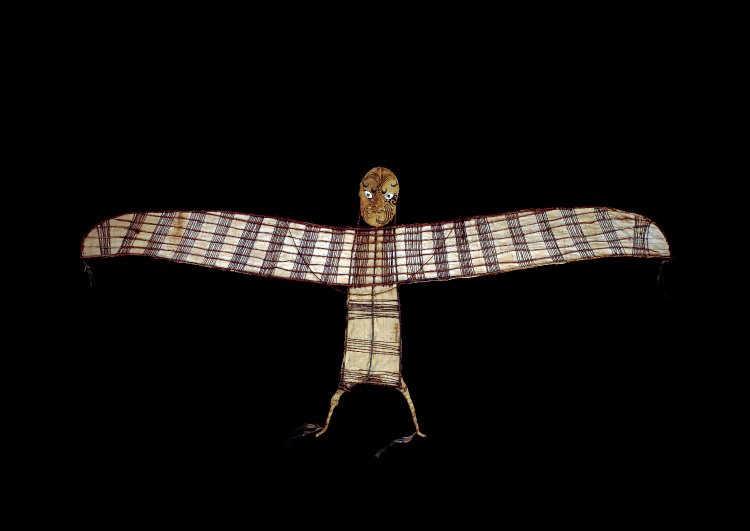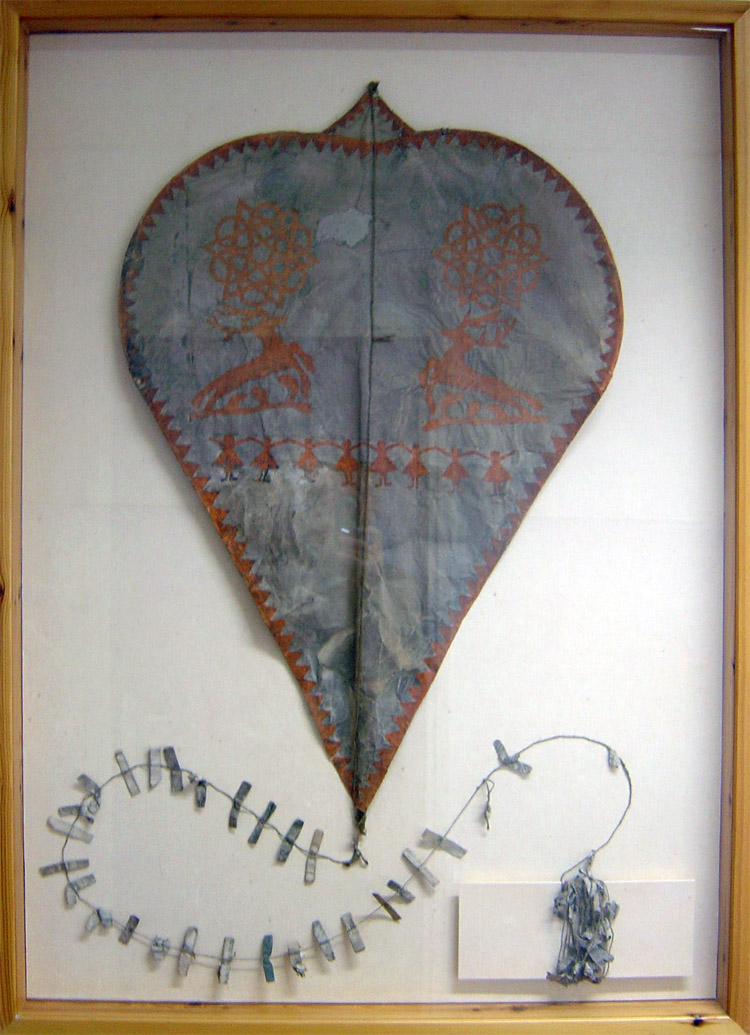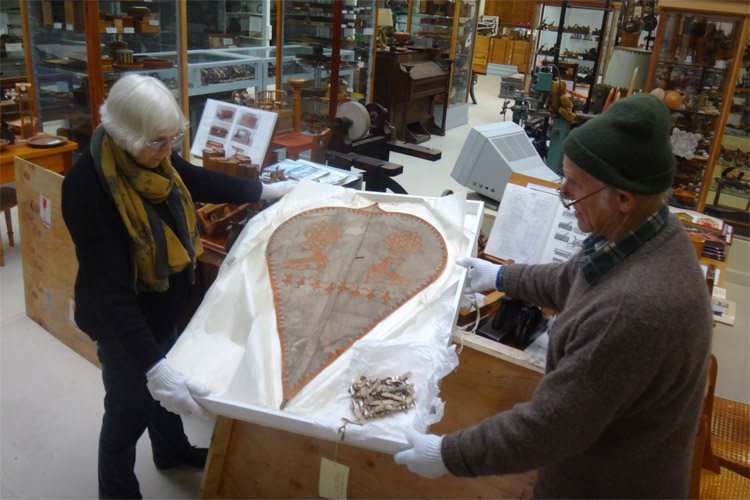Peter Lynn is one of the most experienced kite designers in the world. Here's the story of how he found the oldest known kite.
"I remain hopeful that one day, a midden somewhere in Southeast Asia will reveal datable remnants of a leaf kite that will push the known origin of kites back beyond 10,000 years.
A pretty good proof would be a piece of Locoloco leaf-spine with a line tied around it at an appropriate bridle point.
Maybe such a piece has already been found but has remained unrecognized because discoverers, lacking kite knowledge, are unaware of its significance.
Early kite history is severely handicapped by indigenous kites having been, necessarily, made from biodegradable materials.
Except in unusual environments - and there are no kites amongst the vast array of everyday items in pharaoh's tombs, almost certainly because kites were unknown to the early Egyptians - kites degrade to unrecognizability in a matter of years, even in dry, stable environments.
I've already had to dump various silk, paper, and bamboo kites collected in the 1970s and 1980s because the silk disintegrated, the paper turned into holes, and the bamboo split and warped.
Kites in Museums
With very careful curating, some older Asian kites have survived in recognizable (though faded) form for a little more than 100 years, but not much more that I'm aware of from the collections and specialist kite museums I'm familiar with.
There are a few kites in national museums that are older than this, one being in the British Museum.
This is a Maori "manu aute" birdman kite from the Bay of Plenty in New Zealand, collected in 1843 and probably dating from not much earlier than this:

It is in such fragile condition that it cannot now be taken out of the museum and hasn't been exhibited since 1998.
One kite that is older than this is known. It's of a style called "French Pear Top" and has writings on it: "RB and TB 1773."
It was found by a carpenter when he lifted the attic floor during the renovation of a building at 127 Breestraat, Leiden (Netherlands) in 1985.
When I first saw this kite, it was in a case on the wall at Vliegerop (a kite shop then owned by Gerard van der Loo) in Den Haag in the late 1980s, and I was able to purchase it from Vliegerop about ten years ago.
It then went to the Drachen Foundation in Seattle, where Thom Shanken, a forensic coroner from New York with an avid interest in history, investigated its provenance.
Because there's fraud and forgery in the antiquarian world (for personal gain, the support of a theory, or even just to get one over fellow "experts"), this involved a detailed and skeptical look at its every aspect.
One of Thom's first questions was its provenance from 1985 to 2007 - he wanted to assure himself that what we have now is the same kite that was found in Leiden in 1985.
Personally, I had no doubts about this as I'd had a good look at it back when I first saw it and can attest to it being the same kite now - with the same decorations, initials, and date.
Nor, for this kite from this place, did there seem to be any of the agendas that motivate the forgers of fraudulent maps, for example. But then again, I'm not a particularly suspicious person.
Flying Since the 18th Century
In any event, this concern was allayed as a detailed study established that the kite we have now, whatever happened to it between 1985 and 2007, was indeed very likely first made and flown in the late 18th century.
The first step in this was to consider whether the materials used in its construction "were consistent with the claimed age."
This was established by examination of the paper, string, dating of the book pages used for the tail, the type of glue, and many other details.
But what if some clever forger had constructed it more recently using late 18th-century materials?
By building and flying replicas, Thom then discovered minutia in the tensioning of the bow and its later reinforcement that make the possibility of it being a forgery highly improbable.

With this and the weight of other evidence, his conclusion is that it's likely to be genuine and was probably made by two young boys.
I'm not sure about the two young boys bit - the standard of construction and decoration seems high.
By the age of 12, while being a prolific kite builder, I doubt I could have produced something of this standard, though children back then were maybe a lot better at this sort of stuff.
But I also believe it to be a genuine and original 18th-century kite, except that it does look to me like someone, since 1985, may have penciled over the original date to make it more readable.
This 1773 date, although probable, does not definitely indicate that the kite was built in exactly that year in any case.
930mm along the spine, 630mm wide; amazingly, it's in flyable condition - the paper covering is pliable, and the sticks (I've been told they're hazel, Corylus avellana) are sound.
The spine is round wood straight from the nut tree.
The covering is patched, and there's been skilled tuning of the bow (which is whittled), suggesting the kite had been flown, damaged, repaired, and flown again.
A well-used and well-loved kite, I would say.
A feature is that the bridle (we used to call them belly bands when I was a kid) is quite tight to the surface of the kite, and the line attachment point is a long way to the rear.
In my experience, this suggests that it would require quite strong wind to fly, which is why I will never try it.
The tail is of the traditional bow-tie type, in this case, the ripped-out pages of an 18th-century Latin book.
But what do we know about RB and TB? Who's kite was it?
Alas, it's conjectural, but I imagine that these are the initials of two children (most likely from the same family) who made the kite or for whom it was made (more likely, I think).
Property records for Leiden from this period still exist (but are expensive to access), and having the address, one day, it may be possible to know more about who they were.
Also significant is that its construction and features are very similar to those of the kites I made and flew as a child.
The shape (though we more usually made diamond kites), the sticks, paper, glue, decoration, and tail had not changed substantially in the seven or so generations that passed until I started making kites in the 1950s, on the other side of the world.
Two days ago, it finally arrived in Ashburton and will be displayed in the Lynn Woodworking Museum at the Plains Vintage Railway and Historical Village.
Or it will be when we have established that difficult balance between making it viewable while preserving it in good condition for the next 244 years.
Controlling temperature and humidity – and shutting out UV light - are considerations about which I will need to get expert advice.
This museum was my father's life's work, and I am pleased to be able to make a second contribution to its attractions. The other is the German reciprocating antique sawmill, ex Hoberg, that has now found a home there."
Words by Peter Lynn
